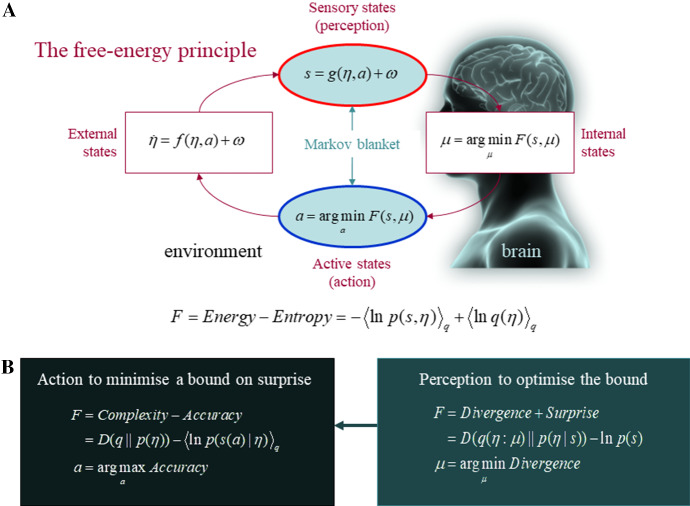Fig. 2.
The free energy principle and self-evidencing. Upper panel: depiction of the quantities that define an agent engaging in active inference and its coupling to its ecological niche or environment. These are the internal states of the agent (), sensory input , and action . Action and sensory input describe exchanges between the agent and its world; in particular, action changes how the organism samples its environment. The environment is described by equations of motion, , that specify the (stochastic) dynamics of (hidden) states of the world . Here, denote random fluctuations. The free energy () is a function of sensory input and a probabilistic belief that is encoded by internal states. Changes in active states and internal states both minimise free-energy and, implicitly, self-information. Lower panel: depiction of alternative expressions for the variational free-energy, which clarify what its minimisation entails. With regards to action, free-energy can only be minimised by increasing the accuracy of sensory data (i.e., the selective sampling of predicted data). Conversely, the optimisation of internal states through perception makes the probability distribution encoded by internal states an approximate conditional density on the causes of sensory input (by minimising a Kullback–Leibler divergence between the approximate and true posterior density). This optimisation tightens the free-energy bound on self-information and enables the creature to avoid surprising sensations through adaptive action (because the divergence can never be less than zero). With regards to the selection of actions that minimise the expected free energy, the expected divergence becomes (negative) epistemic value or salience, and the expected surprise becomes (negative) extrinsic value; which is the expected likelihood that prior preferences are indeed realised as a result of the selected action. See (Friston et al. 2017) for a full description of the free energy expected following an action.
Adapted from Ramstead et al. (2018a)

